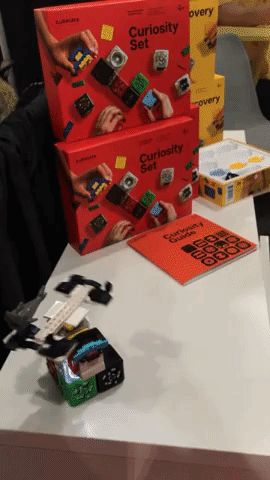This week our assignment was to research a toy and see what the company, parents and kids say about it.
I went to the the NY Toy Fair (the largest in North America!) with some ITP classmates last weekend and was overwhelmed by the quantity and variety of toys. While we were there, we were on the hunt for smart toys. This was a bit difficult because there wasn’t a devoted smart toy section, but we did happen upon some pretty cool (and some really well designed!) toys.
One in particular that I liked was a toy called Cubelets that allows kids to build robots from modular parts. All of the parts - action cubelets, sense cubelets and think cubelets - are in the shape of cubes and they connect with magnets. They remind me of Little Bits because of the physical and modular nature of them and also represent a trend of embodied or tangible computing that I and I think many of us at ITP believe is important. The cubes can also be programmed using Blocky or C. I didn’t get to play with them too much at the Toy Fair, but from what I could see, they seem very intuitive and allow kids to make things quickly and use their imagination. So let’s see what other people think about them!
What the creators say
The website looks very modern and sleek, which matches the minimalist and shiny design of the cubes. Their tagline is “Robot Blocks - The building blocks of better thinkers.” The featured “About Cubelets” video however starts a man who lives in a cabin on a mountain who says he is the inventor and compares cubelets to ecosystems in nature, which doesn’t seem consistent with the rest of the messaging, although I like the comparison!
The website says that the toys are designed for kids 4 and up. They sell different sets and kits with combinations of cubes ranging from $130 to $2,100. They also sell packs specifically for educators with groups of students ranging from $1,390 for 6 students to $3,900 for 12 students. They also have 50 free lesson plans for teachers with students ranging from pre-K to high school and workshops. It also looks like there is an online community for educators - many people have posted videos on the website of how they have used cubelets in their classrooms. The website also has a very active blog with examples of how people are using cubelets.
The website describes the blocks as:
“Designed for all learners”
“Complex lessons made simple”
“Knowledge made visible” -
“Creating connections”
“The building blocks of programming”
The language is definitely geared towards learning STEM concepts, trying new things using both creativity and critical thinking. This language seems targeted towards parents, but maybe even more so for educators to help their students learn - they say they also provide “progress monitoring trackers” to help teachers know if their students are understanding concepts. The website highlights communication and teamwork among students and easy integration with existing curricula. So although this is marketed as a toy, it is equally or even more heavily marketed as a learning/teaching tool.
What parents + kids say
I didn’t find many reviews and I didn’t find any explicitly from kids, but here are some main take-aways from what I found:
Design
Theimums said that she likes that the intuitive and modular design because it’s easy for young kids with small hands (her boys are in preschool). Because the blocks can only be connected one way, this is a simple “cause and effect” that helps young kids build.
One STEM teacher said in a YouTube video that she really liked that the cubes are durable because her students drop them all the time and they still work!
A dad on RobotShop said that he thought that the parallel programming method of cubelets was confusing for adults who are used to developing robots by building first and then programming, but that this came naturally to his kids!
Learning
Theimums said that the app experience was great for her as a parent with the options it gave for reprogramming the robots without taking them apart. She also liked that the toy teachers her kids STEM principles. The dad from RobotShop also liked this aspect and echoed the “cause and effect” learning method by saying that it taught his kids to make hypotheses and test them.
Play
theimums said that her kids didn’t want to stop playing when she said that their 25 minutes were up. The dad on RobotShop also said that his kids - a 3 year old boy and 6 year old girl - keep returning to play with them, although the boy tended to be more interested. He said that the robots enable different kinds of play - sometimes they play “intensely” and other times more “casually.”
What I thought most interesting was that he said that he felt there was a strong emotional component to the robots - that they created joyful discovery for his kids.
Price
On Amazon (here and here), a few reviews mentioned the high price tag. However some people thought it was worth it - one reviewer who was able to buy more parts gave a great review and a former educator gave a 5 star review for their ability to teach STEM concepts:








